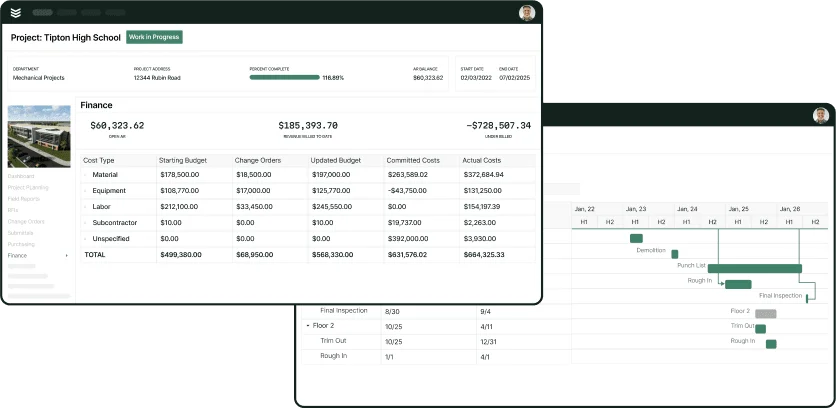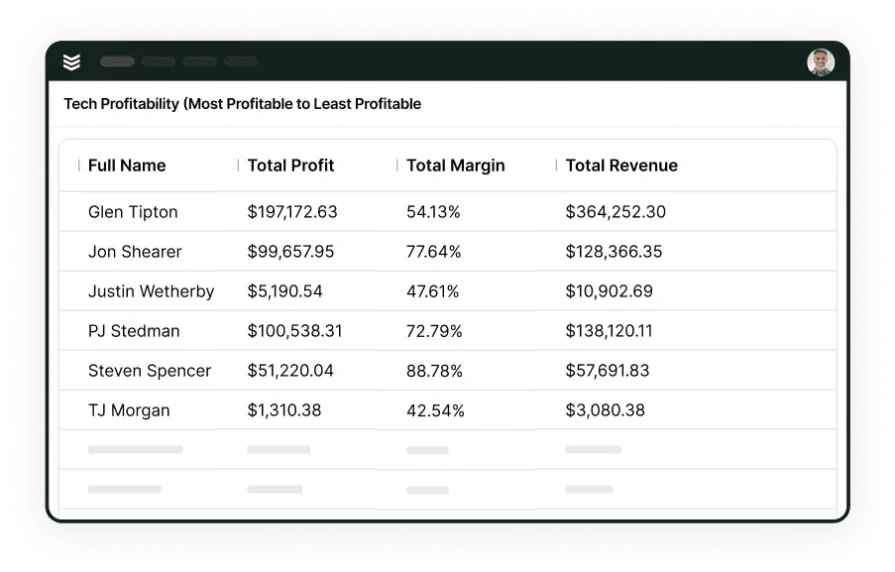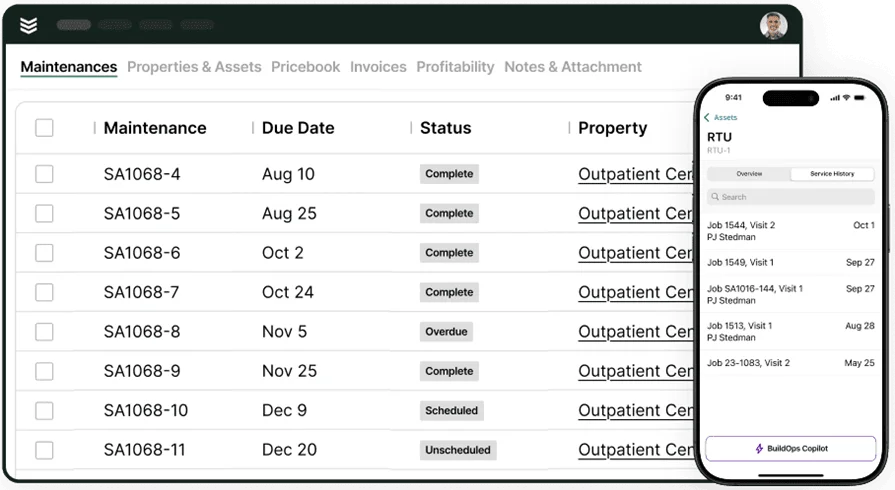You’re wrapping up a rooftop unit repair in the middle of a heatwave. The job’s done, the customer’s satisfied—but what happens next? That service report your tech fills out might seem like paperwork, but it’s actually the heartbeat of your business. It confirms the work completed, protects against disputes, flags future issues, and feeds your ops team the info they need to keep things moving.
In the HVAC industry, where jobs move fast and margins are tight, the HVAC service report isn’t just a recap—it’s your record, your liability shield, and a way to spot missed revenue. And when done right, it also becomes the blueprint for better training, faster service, and stronger customer relationships.
This guide breaks it all down. Whether you’re trying to clean up sloppy reporting habits or build a system your team actually follows, we’ll walk you through what it takes to build reports that work hard for your business.
- What is an HVAC service report?
- What an optimal HVAC service report looks like
- The most essential components of an HVAC service report
- 10 HVAC service reporting best practices to build into your workflow
- How to automate reporting using HVAC service software
- 3 important HVAC service report FAQs answered
Next, we’ll get into the essentials—what makes up a solid HVAC service report, where most teams go wrong, and why getting this right is a game-changer for commercial contractors. Ready to dive in?
What is an HVAC service report?
An HVAC service report is a document that breaks down the work completed by a tech during a service call. It lays out what the issue is, which HVAC system was worked on, what parts were used or replaced, and what still needs attention—whether it's a follow-up repair, maintenance, or a part on order.
These reports matter to both sides. Customers use them to understand what was done and why, especially if the issue isn’t fully resolved on the first visit. It gives them peace of mind and a record they can reference later. For your team, HVAC service reports act as documented proof the work was performed, and a source of truth if a job gets questioned or escalated down the line.
Internally, these reports fuel everything from inventory tracking (what parts were pulled from the truck and what shape they were in) to job costing (how long did the fix take and what labor was used). They also give insight into technician performance—like how quickly techs are resolving issues, whether repeat visits are happening too often, and how well your crew is sticking to service checklists.
What an optimal HVAC service report looks like
Even the most detailed HVAC report won’t do much good if it’s cluttered, inconsistent, or hard to read. Clean, well-structured reports make it easier to track job progress, evaluate technician performance, and identify patterns tied to metrics like first-time fix rate or job duration—two of the most important field service KPIs. Whether you’re reviewing reports in the office or using them in the field, the way they're formatted can make or break how effective they are. Here are key qualities that make HVAC service reports more effective and easier to use:
- Standardized formatting – Every report should follow the same structure across your team. That means same field order, same terminology, and clear sections for different types of input (issue, resolution, parts, notes, etc.). It cuts down on confusion and makes review much faster.
- Digitally completed – Reports should be filled out on a tablet or mobile device—no more handwriting. Digital entry reduces mistakes, enables fast sharing, and keeps everything readable and organized in your system.
- Pre-filled fields where possible – Pull in known info like customer details, equipment model numbers, and job address automatically. This saves time for techs in the field and ensures critical info doesn’t get skipped or misspelled.
- Mobile-friendly layout – The report should be easy to complete in real time on a phone or tablet without scrolling endlessly or flipping between screens. Fields should be logically grouped, easy to tap through, and support photos or notes on the spot.
- Synced with backend systems – When a report is submitted, it should immediately connect with scheduling, quoting, invoicing, and any active service agreements. This removes manual re-entry and keeps your operations moving without lag.
- Searchable and shareable – Archived reports should be easy to find and send—whether it's for a warranty claim, a customer follow-up, or internal tracking. Make sure reports are stored in a system where they can be pulled up by date, address, asset, or technician.
The most essential components of an HVAC service report
A solid HVAC service report should do more than check a box—it should tell the full story of the job. These six elements ensure your team captures the right details every time, no matter who’s on the call or what type of system they’re servicing.
1. Basic technician and site info
Every report should start with the technician’s name, role, or certification (especially if EPA credentials are required), and the property address. Include the customer’s contact info so any follow-up is simple. If the job was assigned through dispatch, noting the work order number keeps everything traceable.
2. Summary of the problem and fix
Lay out the issue the tech was called in for and what steps were taken to resolve it. Whether it was low refrigerant, a tripped float switch, or a faulty economizer, this section needs to clearly explain what was wrong and how it was handled—no guesswork needed later.
3. System details and materials used
Document the unit type (like RTU, mini-split, or packaged system), model and serial number, and any components serviced or replaced. Parts used should be listed clearly—filters, motors, sensors, even sealant or cleaning chemicals if relevant.
4. Time on site
Record the time the tech arrived, how long the job took, and when they left. It’s not just about accountability—it helps track efficiency and provides solid data for job costing, staffing needs, and recurring issues that might be dragging out visits.
5. Notes for follow-up or further action
If the tech spotted something that doesn’t need fixing today but should be watched—or if a second visit is needed—note it here. That might be a failing contactor, rust buildup, or outdated controls. It’s how today’s visit leads to tomorrow’s booked job.
6. Sign-off from both sides
There should be a spot for both the technician and customer to sign. The tech signs to confirm everything was completed as listed, and the customer signs to acknowledge the visit, approve future work (if any), and confirm they’re aware of what was done.
That’s the structure every report should follow. Next, let’s talk through the best ways to make reporting consistent across your team and actually useful to your operations.
10 HVAC service reporting best practices to build into your workflow
A good HVAC service report doesn’t just check a box—it tells the story of the job from start to finish. But without consistency, these reports turn into a guessing game for whoever reads them next. Clear, detailed reporting helps your techs stay aligned, keeps your customers informed, and gives your office team what they need to schedule, quote, or close the loop without chasing people down.
These best practices make HVAC service reports easier to write, easier to read, and a whole lot more useful in the field and back at the shop.
1. Standardize your reporting format
Use the same structure across every report—same fields, same layout, same flow. It helps technicians know what to fill out and helps your office team process reports faster.
Expert Tip
Starting with a structured HVAC service report template gives you a solid base to build from. When everyone’s using the same format, mistakes and missed info drop off quickly.
2. Be specific about the system and location
Each job should clearly identify the exact system worked on—brand, model, location on-site, and whether it’s part of a larger setup like a multi-zone VRF or packaged rooftop unit. This is especially important for sites with multiple systems across large buildings or campuses. Techs coming back later won’t waste time figuring out what was serviced or where to go.
3. List all parts and materials used
From capacitors and filters to refrigerant types and sealants, list every item used during the visit. This doesn’t just help with inventory—it gives your team visibility into what’s being used most often, what’s wearing out fast, and where recurring failures might be happening. Accurate material logs also keep your billing tight.
4. Document findings—even if no repair was made
If the system is running fine today, that doesn’t mean it will be next week. Techs should still log what they inspected, what condition components were in, and any signs of wear. This shows the customer you took a real look and gives your team something to reference if the system fails later.
5. Use clear, technician-friendly language
Skip the vague notes like “checked system” or “all good.” Reports should explain what was checked, how it performed, and why no action was needed—or why action was taken. Writing for clarity avoids confusion later when someone else is reviewing the work or scheduling follow-ups.
6. Include before-and-after photos when possible
Photos help back up your written notes and show what the tech actually did—whether it’s a cracked heat exchanger, a dirty coil, or a cleared drain line. These visuals are useful for customer communication, internal training, and protecting your team from disputes later on. Make photo capture part of the reporting habit, especially for larger jobs or any situation where you’re recommending future work.
7. Flag recurring issues or high-risk components
If a blower motor keeps locking up or a control board has already been swapped twice, that pattern needs to be noted. HVAC systems with ongoing problems should be tracked for future planning—like when to stop repairing and start replacing. Documenting recurring issues helps your team make better service decisions and saves your customer from a cycle of short-term fixes.
8. Tie reports into HVAC service agreements
If a customer is on a service contract, your reports should reflect the tasks promised under that agreement—such as quarterly filter swaps, coil cleanings, or priority response notes. Keeping these reports in sync with your HVAC service agreements helps avoid misunderstandings and ensures your team is delivering what was agreed upon. It also makes renewal conversations easier when you can point to completed work.
9. Sync reporting with your office software
Your HVAC service report shouldn’t live on a clipboard or sit on someone’s phone for three days. It needs to hit the system fast—so dispatch, billing, and management can take action if needed. The best way to make that happen is by connecting your reporting process to an integrated HVAC service platform that ties together scheduling, job tracking, and technician input in one place. This ensures reports are submitted in real-time and nothing slips through the cracks.
10. Train techs on reporting expectations
Even the best system fails if your team doesn’t know how to use it. Train your techs not just on how to fill out the form, but on why each section matters—what the office needs, what the customer sees, and how it affects job history. A quick walkthrough in your next team meeting can go a long way toward cleaner, more useful reporting.
How to automate reporting using HVAC service software
Filling out reports by hand slows your team down. It’s easy to forget details when you’re rushing between jobs, and even small errors can turn into major headaches back at the office. On top of that, handwritten forms are harder to store, search, and share. If a report goes missing or the writing is hard to read, you’re stuck chasing people for answers—or worse, repeating work.
HVAC service software solves that by giving your techs a faster, more reliable way to complete reports in the field. It also keeps all your data connected across systems, so your team isn’t re-entering the same job info in three different places.
Here’s how automation improves your HVAC reporting:
- Standardized digital templates make it easy for every tech to follow the same reporting structure, no matter who’s on the job.
- Pre-filled data fields pull in job, customer, and asset info from your existing system, so techs don’t waste time typing what’s already known.
- Instant file routing pushes completed reports directly to where they need to go—job history, invoice prep, maintenance tracking, or customer records.
- Real-time syncing means your back office sees what techs submit as it happens, through HVAC field service dashboards that keep everyone aligned.
Automating HVAC service reports isn’t about speed alone—it’s about accuracy, consistency, and giving your whole team access to job data while it’s still fresh. The result: fewer delays, fewer mistakes, and a smoother experience for your techs and your customers.
5 HVAC service reporting software features to look for
Manual reporting slows your team down—and creates more room for errors, delays, and lost details. What HVAC contractors need isn’t just a digital form, but a connected system that handles reporting while syncing with scheduling, quoting, invoicing, and everything in between. That’s where a true HVAC service report app comes in. It’s not just about logging the job—it’s a platform that automates how reports are created, shared, and used across your entire operation.
When evaluating HVAC software, look for features that support the full life cycle of a job—not just the paperwork at the end. Here are five essentials to keep on your list:
Here are five features to look for when evaluating service reporting software:
1. Built-in reporting and analytics tools
A good HVAC platform doesn’t just store your service reports—it helps you spot what’s working and what’s not. With reporting tools, you can track data like average time to complete seasonal PMs, which rooftop units are driving repeat visits, or how many service calls led to replacements. This kind of insight helps you make better decisions on staffing, inventory, and recurring issues across your commercial HVAC accounts.

Get insightful reports with BuildOps
Every field can generate a report so your data is always working for you.
2. Technician mobile app
Techs in the field need to document service without slowing down the job. A technician mobile app built for HVAC should let them pull up past work on a specific AHU, log refrigerant levels, note airflow problems, and snap before-and-after photos of repairs. It should also let them mark off PM checklist items—like coil cleaning or belt inspections—without flipping through paperwork. Everything gets logged in real time and shared back with the office automatically.
3. Integrated service agreement tracking
When you're managing hundreds of HVAC service contracts across multiple buildings, nothing can slip through the cracks. With service agreement tools, the software auto-loads the correct tasks onto the service report—whether it’s quarterly filter changes, drain line flushing, or checking economizer settings. That way, every visit aligns with what was promised, and your reports serve as proof of performance if customers ever ask.
4. Invoicing & payments directly tied to service reports
A completed report should kick off the invoice without anyone having to retype labor hours or part usage. Invoicing tools that are integrated with HVAC reporting allow you to convert a rooftop unit repair into an invoice with the exact materials used—capacitors, relays, refrigerant—all pulled straight from the report.
And with HVAC payment tools, you can collect payments faster—whether it’s a card swipe in the field or a digital invoice sent to the client after service. This ensures your jobs close cleanly, without chasing down missing details or unpaid balances.
5. Quoting built into your workflow
Every HVAC tech spots opportunities in the field—worn contactors, oversized RTUs on their last leg, disconnected controls that limit efficiency. A quoting tool that pulls directly from the service report lets your team build and send a professional quote before they leave the site. This closes the gap between field observations and follow-up revenue, making it easy to turn findings into next steps without losing momentum.
Expert Tip
Service reports are only as useful as what they connect to. With BuildOps HVAC software, reporting ties directly into quoting, invoicing, and technician workflows. It’s everything your field service team needs in one platform.
Top 3 HVAC service report software & tools
When it comes to HVAC service reporting, not every platform offers the flexibility and integration field teams need. These three software options stand out—each serving a different type of contractor—but not all of them are purpose-built for handling detailed HVAC reports across commercial operations.
1. Best for commercial: BuildOps
BuildOps is designed specifically for commercial HVAC contractors who need reporting to work hand in hand with scheduling, job costing, dispatch, and service agreements. It helps teams capture everything from service notes and part usage to photo documentation—all in real time and tied directly to the job, asset, and customer record.
How pricing works: Pricing is tailored to the size of your business, the number of techs, and the workflows you want supported. You only pay for the tools you’ll actually use.
Key features built for commercial HVAC reporting:
- Real-time service reports with photo capture, timestamps, and technician notes
- Linked reporting across work orders, assets, and customer history
- Custom report templates for commercial PMs, inspections, and diagnostics
- Built-in quoting, invoicing, and agreement tracking
- Mobile app made for field use on complex job sites
What sets it apart for commercial contractors: BuildOps connects HVAC reporting to every part of your workflow—from initial dispatch to closeout—without needing third-party tools or spreadsheets.

Give BuildOps a Try
Give your HVAC team everything they need in one connected platform.
2. Best for residential: ServiceTitan
Image Source: ServiceTitan
ServiceTitan is a good option for residential HVAC businesses, especially those managing recurring maintenance jobs and high volumes of daily appointments. It handles dispatch, customer communication, and CRM-driven workflows well—making it a solid fit for home service teams. However, it lacks deeper commercial-level reporting tools—like asset tracking, complex service logs, or system-specific job history—which limits its use for more advanced HVAC workflows.
How pricing works: Pricing is based on user licenses and feature access, with separate tiers depending on the tools and integrations your business needs.
Key features designed for residential HVAC service:
- Technician-friendly mobile app
- Appointment booking and CRM integration
- Membership and recurring service management
- Built-in payment collection and job history tracking
- Simple job reporting tools for residential work
What sets it apart for residential contractors: ServiceTitan focuses heavily on the customer experience, helping techs stay on schedule and keep homeowners informed with real-time updates and reminders.
3. Best for general contractors: Workiz
Image Source: Workiz
Workiz is geared toward general contractors managing a mix of HVAC, plumbing, electrical, and appliance repair. It’s easy to set up, lightweight, and flexible enough to support basic reporting, scheduling, and technician GPS for smaller, fast-moving teams. That said, Workiz doesn’t offer in-depth HVAC reporting features like asset-level tracking, commercial PM logs, or integrated service agreements, which limits its utility for larger HVAC-focused operations.
How pricing works: Workiz offers tiered pricing based on the number of users and features, making it affordable for smaller teams with multi-trade operations.
Key features designed for general contractor workflows:
- GPS tracking and live job status updates
- Job booking and call handling
- Mobile access for field crews
- Cross-trade calendar and scheduling
- Simple job reports for mixed service work
What sets it apart for general contractors: Workiz makes it easy to manage jobs across multiple service types without requiring deep configuration—great for lean teams with diverse job scopes.
Who needs HVAC service reporting software?
If your team handles more than a handful of service calls a week, HVAC service reporting software isn’t optional—it’s necessary. Any shop that dispatches techs for routine maintenance, emergency repairs, or system replacements can benefit from digitized, connected reporting.
Whether you’re a five-truck operation or running crews across multiple regions, the right platform helps you stay organized, reduce callbacks, and keep customers informed. Here’s who sees the biggest impact:
- Service managers who need visibility into job performance, open work orders, and technician productivity
- Dispatchers trying to track status updates, verify job completion, and stay ahead of scheduling conflicts
- Technicians who want to spend less time on paperwork and more time solving real problems in the field
- Back office teams handling invoicing, quoting, or warranty documentation who depend on clean, accurate job records
- Business owners focused on scaling efficiently while maintaining quality and accountability
If any part of your workflow depends on knowing what was done, when, where, and by whom—this kind of tool pays for itself fast.

Book more HVAC jobs
See how commercial HVAC companies achieve long-term growth.
3 important HVAC service report FAQs answered
Even experienced HVAC contractors run into questions when it comes to service reporting—especially when switching from paper to digital, or training new techs. Below are a few of the most common questions we hear, with clear answers to help you build a stronger reporting process across your team.
1. Who fills out HVAC service reports?
Service reports are completed by HVAC technicians in the field—usually right after a completed job. Techs should document HVAC service because they directly observed the issue, diagnosed it, and performed the repair. It informs the office and the customer about the work completed and any follow-ups.
2. Who are HVAC service reports actually for?
They serve two main purposes: internal job tracking and customer communication. Customers use them to verify work, understand what was serviced, and keep a record for future maintenance or warranty claims. Internally, HVAC teams rely on these reports to schedule future service, manage contracts, bill accurately, and spot trends like repeat issues or underperforming units.
3. What are the benefits of creating and using HVAC service reports effectively?
When HVAC service reports are consistent, complete, and tied into your broader workflow, they become more than just paperwork—they become a key part of running a tighter operation. Here’s what your business stands to gain:
- Better communication between teams – Reports help techs, dispatchers, and back office staff stay aligned by making job details available in real time. No more guessing who did what or calling techs to fill in the blanks.
- Fewer customer disputes – A signed, detailed service report showing what was fixed and why gives you clear documentation if customers raise questions later. This is especially important for high-value equipment like rooftop units or VRF systems.
- Faster turnaround on quotes and invoicing – When reporting tools connect directly to quoting and invoicing platforms, your office team doesn’t have to wait to build the next step. Reports with clear material use and repair notes help convert follow-ups into revenue faster.
- Improved service agreement tracking – Reports linked to PM contracts make it easier to prove that tasks were completed—like quarterly coil cleanings or drain flushes—keeping you in compliance and your customers happy.
- Smarter technician training – Reviewing patterns across service reports helps identify where your team needs coaching. For example, if certain techs take longer on similar jobs or frequently miss upsell opportunities, you’ll catch it early.
- Lower operational costs – Clean, automated HVAC service reports reduce rework, limit billing errors, and speed up internal processes like payroll, parts restocking, and customer follow-up. That adds up to real savings over time.
HVAC service reporting isn’t just a task—it’s a habit that impacts nearly every part of your operation. When done right, it connects your field techs with your back office, turns everyday service calls into future opportunities, and gives customers confidence that your team knows their systems inside and out. Whether you’re tracking equipment performance, supporting service agreements, or catching issues before they become breakdowns, good reporting is what keeps everything running.
The process gets even better when it's backed by the right tools. Platforms like BuildOps give commercial HVAC teams a central place to handle reporting, quoting, scheduling, and follow-ups—without jumping between apps or chasing paper trails. It's about working smarter, not harder.

Curious how BuildOps works?
See how BuildOps helps teams like yours turn service reports into something more.







